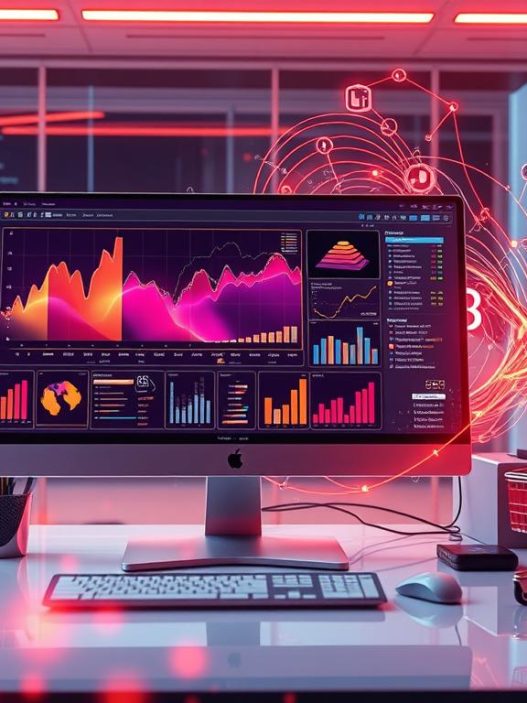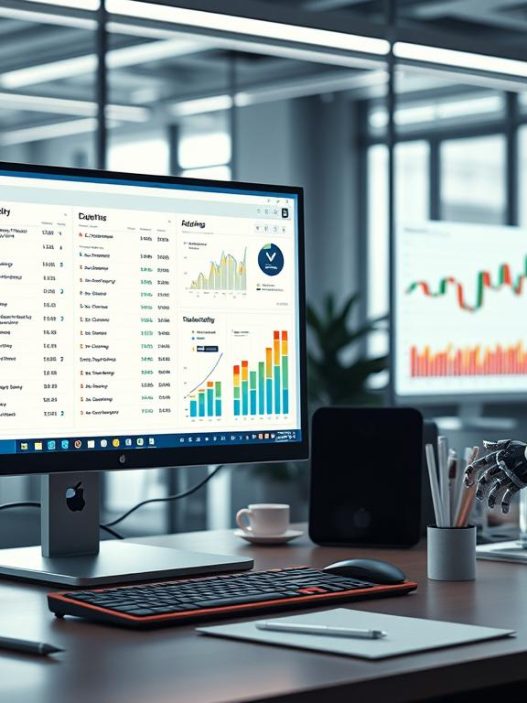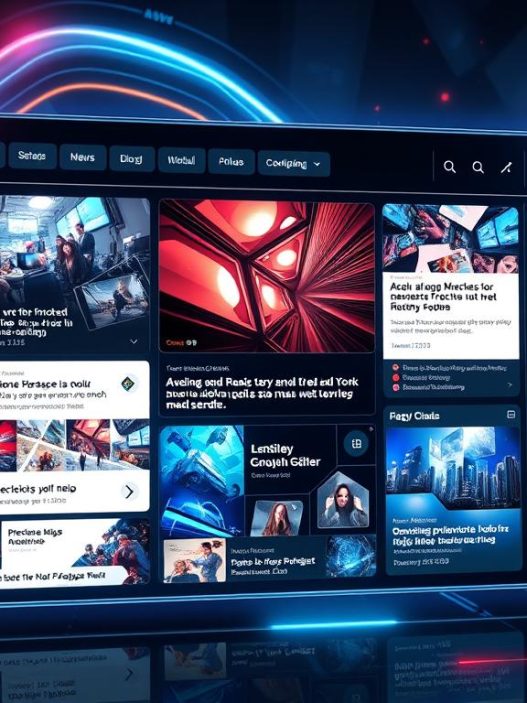The use of artificial intelligence (AI) in understanding retail customer behavior is changing the game for companies. It helps them improve how they work and connect with customers. By analyzing customer behavior, retailers find important patterns in big sets of consumer data. This shift is significant. In 2021, the market for AI in retail was around $4.84 billion. It’s expected to jump to $31.18 billion by 2028.
These insights let stores customize shopping experiences, anticipate what customers will need, and sell more effectively. Using AI, businesses can offer personalized products and come up with plans that cater to what customers like. This makes customers more satisfied and loyal.
Exploring AI in retail shows us how it changes the way businesses grow and operate. It creates new opportunities for expansion.
Key Takeaways
- The AI in retail market is expected to grow from $4.84 billion in 2021 to $31.18 billion by 2028.
- AI enhances the processing and analysis of customer data, enabling proactive business strategies.
- Personalization through AI can lead to a 40% increase in company revenues, per McKinsey.
- Predictive analytics and machine learning empower accurate customer behavior predictions.
- AI-driven insights improve efficiency and accuracy in data analysis while saving resources.
- AI facilitates personalized experiences, boosting customer satisfaction and loyalty.
- Businesses must navigate challenges, such as data privacy and skill shortages, to fully leverage AI.
Understanding the Importance of Customer Behavior Analysis in Retail
Retailers must understand customer behavior to create strong business plans. They watch how people shop and what they like or don’t like. This knowledge shows what customers enjoy, helping companies shape their products and ads.
Impact on Business Strategies
Customer data deeply affects business choices. By using AI for data analysis, retailers get a clear picture of customers’ paths and profiles. They can then match their offerings to what customers want. This matching improves satisfaction and can boost sales.
Companies that focus on customer behavior often see better ad results. They use insights to target their marketing, which really works.
Enhancing Customer Satisfaction and Loyalty
Personalizing shopping experiences helps keep customers coming back. Strategies based on customer behavior show customers they are understood. Studies say companies good at this have more loyal customers.
Personalizing how you talk to customers builds trust. This can increase sales by up to 40%. So, businesses that listen and adapt to customer feedback tend to do well.
| Aspect | Statistics |
|---|---|
| Customer Retention | 60-70% chance of selling to an existing customer |
| Customer Expectations | 63% of B2C and 76% of B2B customers expect brands to understand their needs |
| Customer Feedback | Two-thirds believe companies should listen better to their feedback |
| Revenue Impact | 60% of consumers would buy more from brands that show they care |
The Role of Artificial Intelligence in Retail Analytics
Artificial Intelligence is changing the game in retail analytics. It uses AI to collect and analyze customer data. This lets businesses understand customer behavior better. They can see shopping trends and make smarter decisions to improve.
AI Techniques for Data Collection and Analysis
AI techniques are key in gathering and analyzing data effectively. They help retailers fully use the benefits of retail analytics. These methods include:
- Predictive Analytics: Forecast customer behavior and trends.
- Data Mining: Extract insights from big data sets for marketing strategies.
- Customer Segmentation: Group customers by their buying habits and likes.
- Real-Time Data Processing: Make quick changes to marketing and stock strategies based on current customer actions.
Real-Time Customer Insights
Getting real-time insights into customers changes how retailers connect with them. Advanced AI lets brands meet customer needs instantly. Here are the main advantages:
- Immediate Feedback: Retailers can understand customer responses to products and deals right away.
- Dynamic Pricing Strategies: Adjust prices based on changing demand quickly.
- Enhanced Inventory Management: Keep stock levels optimal by watching customer behavior.
| Statistic | Impact |
|---|---|
| 80% of retail executives expect to use intelligent automation by 2025 | Shows more AI use for decision-making in the future. |
| 6% to 10% revenue increase for brands offering personalized experiences | Points out how AI boosts sales through targeted marketing. |
| AI expected to drive $40 billion in additional revenue over 3 years | Underlines the financial upside of investing in retail analytics. |
| 85% of enterprises projected to use AI by 2020 | Signals quick AI adoption in retail. |
Retail Customer Behavior Analysis Using Artificial Intelligence
Artificial Intelligence (AI) is changing how we understand retail customers. It uses innovative methods like predictive modeling. This approach forecasts customer actions using their past activities. Retailers can learn about customer engagement, purchasing habits, and preferences through this data.
These insights help create strategies that meet consumer needs better.
Predictive Modeling for Customer Behavior
Retailers use predictive modeling to know what customers might need next. It helps keep just the right amount of stock and cut inventory costs by up to 20%. Companies such as Dynamic Yield improve sales with AI. They make personalized product recommendations based on shopping history.
This smart use of AI helps businesses make better decisions and stay profitable over time.
Enhancing Personalization through AI
AI is great at making shopping personal for everyone. For example, Tesco uses AI to understand what customers like. This leads to ads and products just for them. Happy customers mean more sales and loyalty.
A McKinsey & Company study shows businesses that personalize with AI see 40% more revenue than those who don’t.
Utilizing Consumer Data Analysis for Better Insights
Analyzing customer data with AI gives retailers powerful information. This helps them tweak their marketing and what they sell. Big names like Walmart and Target use AI to really get their customers.
This smart tech helps them manage stock better and reduce theft.
| Key Insights | Impact |
|---|---|
| Predictive Modeling | Forecasts customer behavior, optimizes inventory |
| Enhancing Personalization | Increases engagement and revenue |
| Consumer Data Analysis | Informs marketing strategies, improves retention |
| AI Surveillance Systems | Reduces theft-related losses, improves security |
Leveraging Machine Learning for Customer Insights
Machine learning is changing the way retailers understand and connect with their customers. With advanced algorithms, businesses can now divide customers into groups. This helps in creating marketing plans that match customer wants and actions.
Segmentation and Targeting of Customers
Retailers can now send marketing messages meant just for you. They use machine learning to look at what you buy, where you live, and what you like. This helps businesses see different groups of customers and make ads that truly speak to each one.
Brands like Sephora are seeing more customers and selling more because of personalized ads. These ads make shopping feel special for every customer.
Dynamic Pricing Strategies
Dynamic pricing uses machine learning to change prices based on what’s happening right now, changes in demand, and trends. This helps stores keep their prices competitive and make more money. It also meets customer needs better.
Stores like Walmart use machine learning to predict what will sell and how much. This helps them keep just the right amount of stock. This way, they avoid running out of products or having too much left over.
Applications of AI in Retail Customer Behavior Analysis
AI is changing how brands and consumers connect. Retailers are using it to make better marketing plans and improve shopping experiences. This makes a big difference for both the store and its customers.
Designing Marketing Campaigns
With AI, creating effective marketing plans is easier. It looks at what customers like and how they act. This helps brands send ads that speak directly to people. A study found that 71% of shoppers want ads made just for them. With AI, companies can do this well, keeping customers more involved.
Improving In-Store Experience with Behavioral Data
Stores are becoming better places to shop thanks to AI. It helps arrange stores by watching how people shop, boosting sales chances. Some businesses have cut down on excess stock by 20% and made customers happier. By knowing where and how people shop, stores become more welcoming.
| Application | Benefit | Impact |
|---|---|---|
| Tailored Marketing Campaigns | Increased Engagement Rates | Higher Customer Retention |
| In-Store Layout Optimization | Improved Customer Flow | Maximized Sales Opportunities |
| Fraud Detection | Enhanced Security | Cost Savings |
| Predictive Analytics | Accurate Demand Forecasting | Streamlined Inventory Management |
AI is changing retail for the better, focusing on what customers need. It helps online and in stores, driving business forward. Using AI makes things better for everyone shopping and selling.
Conclusion
Retail business is changing because of artificial intelligence (AI). It makes companies understand their customers better. They look at a lot of data from social media, reviews, and what people buy. This info helps them make smart choices and make shoppers happy.
With AI, stores can make ads that speak to what you like. They also get better at managing stock and predicting what will be popular. Happy customers stick around longer. Thanks to AI, companies know what you might buy next. This helps them create effective ads that can boost sales.
The way we shop keeps changing, and AI tools help stores stay ahead. Stores that know what you want quickly and can adapt will keep their customers. Future shopping success depends on using AI to understand and connect with customers. This makes for strong growth and customers who are more involved.









